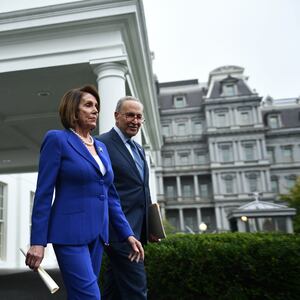PARIS—Donald J. Trump, trying to bluster his way Wednesday through the most disastrous foreign-policy debacle of his presidency, seemed to spit on the graves of more than 10,000 Kurds who died fighting to defeat the so-called Islamic State.
By moving U.S. troops in Syria out of the way, he gave a green light for Turkish forces to slaughter America’s erstwhile allies while ISIS prisoners escape en masse, and the Russians take charge.
“Syria may have some help with Russia, and that’s fine,” Trump said Wednesday. “They’ve got a lot of sand over there. So, there’s a lot of sand that they can play with. Let them fight their own wars.”
But no amount of Trumpian huffing and puffing, threatening and cajoling can change the widespread view in the Middle East—and in Congress—that almost on a whim he collapsed a fragile balance of power, then had to cut and run.
So he blames those he betrayed as if they were servants who failed him, and tries to claim credit for himself for the good that they did. In a deranged meeting with congressional leaders Wednesday, he reportedly declared “I captured ISIS.” He claimed the “overrated” former Defense Secretary James Mattis told him it would take two years. “I captured them in a month.”
Trump didn’t do any capturing in fact. The Kurds did that.
And Trump in another appearance decided to denigrate them.
“The Kurds know how to fight and as I said they are not angels, they are not angels,” Trump said during a photo-op with the Italian president. “Take a look. You have to go back and take a look. And they fought with us, and we paid a lot of money for them to fight with us.”
Well, let’s do that. Let’s look at this force that Trump clearly views as nothing more than an army of mercenaries. Did they really “save the sum of things,” as the poet A.E. Housman once wrote, “for pay”?
If so, then however many millions of dollars were spent, the United States got a lot more than its money’s worth, because when the Islamic State surged across Syria and Iraq like a tidal wave of terror in 2014, all the other armies in the region, including those in which the U.S. had invested billions, were found to be complicit or corrupt and cowardly.
Early in the Syrian conflict, Bashar al-Assad, the tyrant in Damascus, decided to cast his fight against democracy as a fight against Islamic terror—and to that end released the many Islamic terrorists he had in his prisons. His regime knew them well, having facilitated their insurgency in neighboring Iraq against the United States and its allies.
Mahmud al-Naser, a defected Syrian intelligence officer interviewed for a series on Assad-ISIS collusion published by The Daily Beast in 2016, said the service he worked for estimated 20,000 people crossed into Iraq as the U.S. began its attack in March 2003. Most returned after the fall of Baghdad three weeks later. But an additional 5,000 crossed for reasons of religious ideology—and they were “what gave birth to the monster” that became ISIS.
In the years that followed, Assad and his Russian and Iranian allies fought ferociously against other insurgents, but left ISIS virtually untouched as it built its “caliphate” in eastern Syria and grew rich selling oil to the Assad regime among others.
In June 2014, ISIS moved against Mosul, the second biggest metropolis in Iraq. The government’s soldiers there had been trained by the U.S. and armed by the U.S. at enormous expense over the course of 11 years, and greatly outnumbered the ISIS forces. But the Iraqi military was rife with corruption. Many of the soldiers it had on its books were called “astronauts” by the locals because they orbited very far from their units. In fact, their officers were pocketing the soldiers’ salaries. And the problem grew worse as ISIS advanced deeper into Iraq, eventually threatening even Baghdad.
“The astronaut phenomenon is destroying the Iraqi army,” one officer, Kadhim al-Shammari, told the news site Niqash, a partner of The Daily Beast. “There are senior officers who are making deals with dozens of their men, giving them vacations for months in return for part or all of the men’s salaries.”
Abbas al-Saadi, a soldier who should have been stationed near Tikrit where his unit was fighting ISIS, was working instead as a taxi driver in the capital.
“If I was killed, who would look after my wife and three children?” he asked. “I love the military but I am worried about ISIS. They not only kill soldiers in battle, they behead them and burn them. That’s why I decided to give all of my salary to the officer in charge of our unit so that he would register me absent with leave.”
The Obama administration did not begin to recognize fully the kind of threat ISIS posed until after the fall of Mosul, and it did not begin to take serious action until August, when ISIS captured the town of Sinjar and began the systematic massacre of the Yazidi population, whose ancient religion was condemned as devil worship. Thousands of men were killed, women were raped and sold as slaves, children were taken to be indoctrinated in the ISIS version of Islam and turned into fighters.
As tens of thousands fled to the mountain above the town, the U.S. dropped food to the refugees and began to bomb ISIS positions. But someone needed to defend people on the ground, and the forces of Iraq’s Kurdish Regional Government, the vaunted Peshmerga, had withdrawn.
The Kurds who stood their ground, as The Daily Beast reported at the time, were those from neighboring Syria, members of the so-called People’s Protection Units, or YPG, a militia affiliated with the Turkish-Kurdish PKK, designated a terrorist organization not only by Ankara but also by Washington.
The PKK, or Kurdistan People’s Party, has fought a decades-long insurgency against the Turkish government, following a radical leftist ideology and employing terrorist as well as conventional guerrilla tactics. YPG fighters and supporters often brandish the image of PKK leader Abdullah Ocalan, now in a Turkish prison. But their bravery is legendary, and the YPG particularly is famous for its many women warriors, who were much in evidence fighting back against ISIS forces during the flight from Sinjar.
When Yazidi refugees hit a checkpoint where peshmerga were confiscating unauthorized weapons they sent word back down their convoy: “Give your guns to the YPG!”
That same August, ISIS set out to horrify the United States, Europe, and anyone else who might challenge its power with a series of gruesome executions. Journalist James Foley and others were beheaded. Calls for the Obama administration to do something intensified, but there was no taste for a new deployment of American fighters on the ground in the Middle East. A competent local force had to be found.
It wasn’t easy for the United States to join forces with the YPG. There were no illusions about its close ties with the terrorist-designated PKK up to that point, and pulling together an alliance of local forces to fight ISIS was a little like the problem building an effective resistance to the Nazis in World War II. Many people back then were uncomfortable working with communists who revered Joseph Stalin, but the communists were among the most dedicated fighters.
Then, in September 2014, ISIS laid siege to the town of Kobani on the Syrian-Turkish border.
For a year at least, Turkish authorities had watched as thousands of Islamic extremists from around the world flooded into Syria to fight Assad and, in many cases, to join ISIS. Now the Turkish military—soldiers in NATO’s second biggest army—simply watched as the people of Kobani faced the ISIS onslaught. And once again, it was the Kurds of the YPG who went toe to toe against the Islamic State.
“Turkish soldiers are meters away patrolling the fence, more to stop Turkish Kurds from joining the fight than to protect the country from Islamic militants besieging the Syrian border town,” wrote The Daily Beast correspondent on the scene. “In the distance, black smoke is swirling from the western and northern sides of Kobani, the last redoubts of the few hundred YPG fighters who are there fighting for their lives. They control only about a third of the town now, YPG sources inside tell me, and the question remains how long they can defy the odds and prolong their last stand in a battle that resonates every bit as powerfully for Kurds as the Alamo once did for Americans.”
Weeks and then months passed as the U.S. began supplying quantities of weapons to the Kurds, and used air power to support them, until finally, in January 2015 the siege was broken—and so was the myth that ISIS was unbeatable.
Asked on Wednesday when the moment came that decided U.S. backing for the YPG, a senior State Department official in both the Obama and Trump administrations answered with one word: “Kobani.”
The war to destroy the territorial claims of the so-called “Caliphate” went on with largely defensive battles to contain an Islamic State that claimed as its objective baqiya wa tatamadad, “remaining and expanding.” And as ISIS felt the pressure, its operatives and sympathizers launched stunning attacks in Europe and the United States. The Bataclan massacre in Paris in November 2015 and the Orlando night-club shooting in June 2016 are just two examples.
Fear spread through Western electorates, fueling a rise in xenophobic populism that helped propel fearmongering Donald Trump, with his call for a ban on all Muslims entering the United States, into the White House.
But the tough job, the fighting on the ground in the Syrian heart of ISIS-land, remained all along with the YPG and Arabs who joined with it to form the Syrian Democratic Forces. They retook Raqqa in October 2017 and delivered the final blow to the Caliphate as a physical territory when the town of Baghouz fell in March this year.
ISIS fighters, Trump declared at the time, “are losers and barely breathing.” He claimed victory, as usual, for himself.
The YPG and SDF had lost thousands of men and women fighters, with many more left permanently handicapped. Are they angels? Perhaps killer angels. With the Americans and other members of the U.S. backed coalition raining death from the sky, they defeated on the ground the Islamic State’s forces of darkness. Are they mercenaries? If so, then truly, they earned their keep when they saved the sum of things.
And Trump? He’s just pissed it all away.








